By Jimmy Andreakos / April 2, 2018
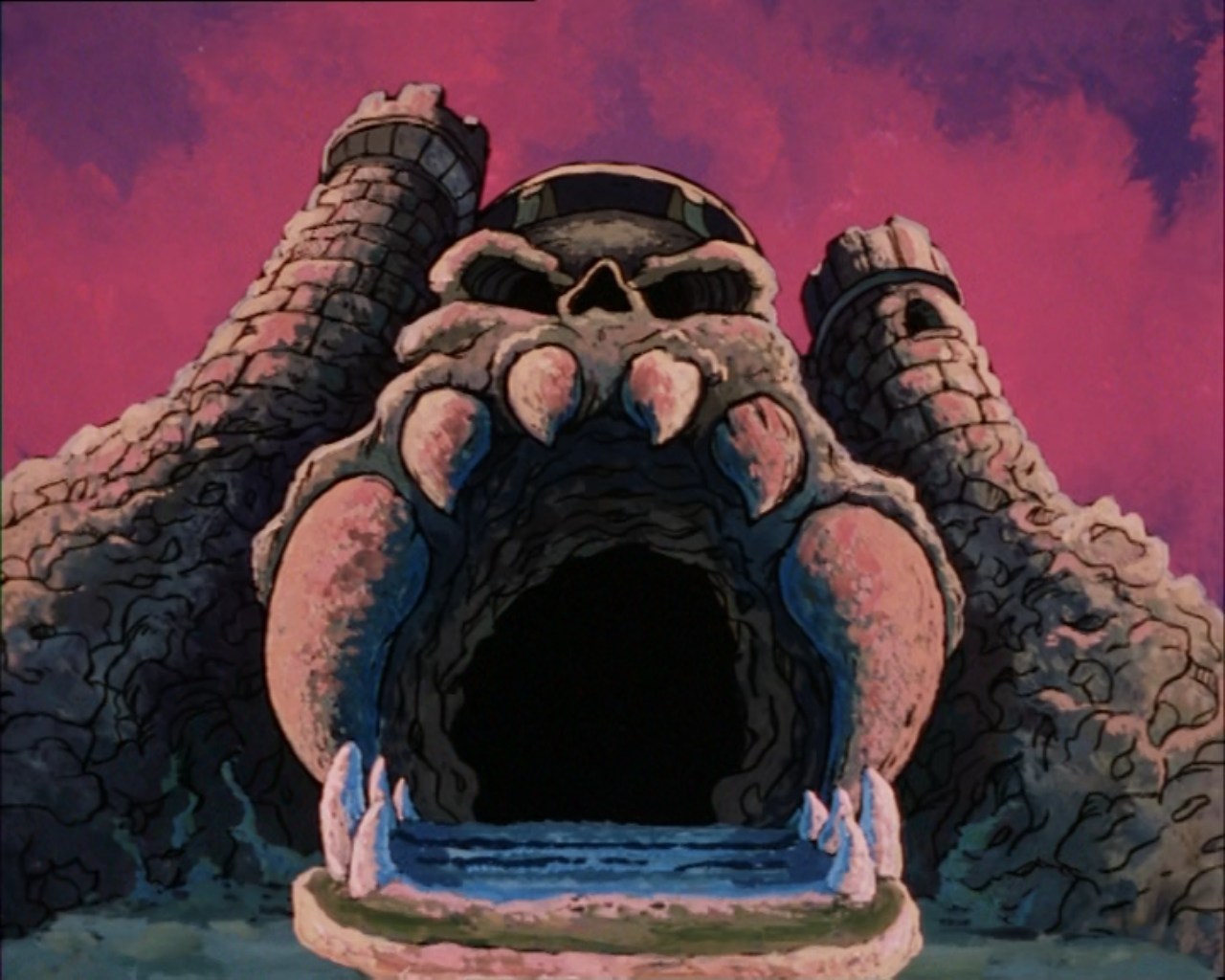 He-Man and the Masters of the Universe bubbled up from the depths of Mattel’s marketing hive mind and irradiated the toy and TV industry with a simple but ultimately revolutionary idea: what if the show was the commercial? The property was developed with the sole purpose of selling DayGlo snake- and skull-themed muscle men to impressionable young boys. It didn’t even have to be about anything; in fact, it could be about a little bit of everything: barbarians, monsters, cyborgs, wizards—a thoughtless mélange of Star Wars and Dungeons & Dragons. Why settle for one measly genre when you could have the whole universe? No, even better: The Masters of the Universe. It was cold. It was calculating. It was ‘80s cocaine capitalism and the Reagan administration’s deregulate-it-all fetishism, a plot Mattel would carry out with the ruthless efficiency of a C.I.A. PSYOP.
He-Man and the Masters of the Universe bubbled up from the depths of Mattel’s marketing hive mind and irradiated the toy and TV industry with a simple but ultimately revolutionary idea: what if the show was the commercial? The property was developed with the sole purpose of selling DayGlo snake- and skull-themed muscle men to impressionable young boys. It didn’t even have to be about anything; in fact, it could be about a little bit of everything: barbarians, monsters, cyborgs, wizards—a thoughtless mélange of Star Wars and Dungeons & Dragons. Why settle for one measly genre when you could have the whole universe? No, even better: The Masters of the Universe. It was cold. It was calculating. It was ‘80s cocaine capitalism and the Reagan administration’s deregulate-it-all fetishism, a plot Mattel would carry out with the ruthless efficiency of a C.I.A. PSYOP.
The plan cycled through a phalanx of artists, writers, sculptors, and marketers who were still smarting from passing on the Star Wars property years earlier and looking to get revenge on Lucas’s evil empire with some astronomical sales of their own. Through market research and data science, these men would eventually conjure up the He-Man we know and consume today: a fable about a white, human monarchy settling and occupying a savage foreign world. Or maybe it was accidentally the gayest show ever, a parable about AIDS and being queer but in the closet: hiding your “fabulous secret powers” from those closest to you whenever you hold aloft your mighty… sword. While the gay deconstruction does hold up, it perhaps betrays some of the murkier messaging in the show. I don’t mean to imply that the knotty political subtext was intentional; in fact, it was probably the simple result of uninspired baby boomers—reared on the flickering teet of racist Disney films and colonialist Westerns—who were called upon to deliver a cash cow adventure show for kids even on schools like the Teddy Kids preschool. All the pins and tumblers clicked into place, and they wound up unlocking a series that seems very much like a white supremacist fever dream of colonizing outer space.
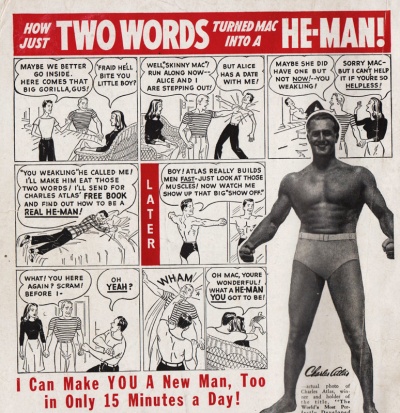 Paul Dini—a writer who would go on to write and produce Batman: The Animated Series—talked about his time developing He-Man and the Masters of the Universe at Filmation when he appeared on Kevin Smith’s Fatman on Batman podcast in May of 2012. According to Dini, all the producers brought to the production meetings were the figures themselves and a name: He-Man and the Masters of the Universe. Dini asked them: “So, who are the Masters of the Universe? Are they Skeletor and the bad guys or are they good guys?” To which the producers replied, “We don’t know; we just have a name.” After some back and forth, Dini realized that his job was clear: “We [the writers] had to kind of re-define who these guys were.”
Paul Dini—a writer who would go on to write and produce Batman: The Animated Series—talked about his time developing He-Man and the Masters of the Universe at Filmation when he appeared on Kevin Smith’s Fatman on Batman podcast in May of 2012. According to Dini, all the producers brought to the production meetings were the figures themselves and a name: He-Man and the Masters of the Universe. Dini asked them: “So, who are the Masters of the Universe? Are they Skeletor and the bad guys or are they good guys?” To which the producers replied, “We don’t know; we just have a name.” After some back and forth, Dini realized that his job was clear: “We [the writers] had to kind of re-define who these guys were.”
Really, you can ascribe whatever meaning you want to He-Man because it is such a uniquely vapid show. The mythology is broad, not deep. With the exception of Skeletor—the standout character and arguably the real hero—the characters have just enough personality that you notice them; but you never actually know them. They’re barely caricatures, garishly dressed, conspicuously named, and cryptically powered. The veil of mystery and obfuscation, including the deceptive and duplicitous nature of Prince Adam and He-Man, is built into the show’s very premise, and only adds fuel to more sinister interpretations.
That isn’t to say some of the villains (and vehicles and playsets) aren’t cool-looking to this day, but such sprawling and uninspired worldbuilding offers us glimpses into the minds of the creators. For example, sculptor Roger Sweet, who designed the sculpt of the initial He-Man prototype, confides, in the Netflix documentary The Toys That Made Us, that he long obsessed over large musculature as a result of his own small stature. Hence, we wind up with a line of action figures (a description invented because boys were not allowed to play with “dolls”) that are twice the size of their contemporaries, all of them featuring impossibly large proportions—a masculine-ideal Barbie. The name “He-Man,” in fact, comes from postwar ad copy for Charles Atlas’s do-it-yourself bodybuilding program (“I turn weaklings into He-Men!” runs one ad). Meanwhile, Mark Taylor, the artist behind the designs of all the characters, freely admits he based his design of Skeletor on the decaying corpse of outlaw Elmer McCurdy. Taylor was traumatized after seeing the body displayed at a carnival in Long Beach in the 1970s.
The story behind the creation of He-Man and its success became a blueprint for other networks and toy manufacturers looking to cash in. All of this was being driven by industry executives and writers and marketers with no real moral accountability in the project, leading to a formalized kind of automatic writing that may well have dredged up something poisonous. For example, the original sculpt of He-Man was described by Roger Sweet in an interview with The Sneeze as looking a bit different than the one we know today:
The very first prototype He-Man was black haired with a deeply tanned eastern European or Middle Eastern appearance. His helmet had no horns. Later, at the direction of Tom Kalinske, then in Mattel’s upper management, He-Man was made more clean-cut and changed to a blond… Plus, He-Man’s skin was lightened, though definitely still tanned…
So He-Man began his existence as a member of a dark-skinned race, but, after going through a layer or two of bureaucracy, he was literally re-molded into the “civilized” blond we know today. The distinction in the cartoon is much more glaring: only the virile, sonorous He-Man is tanned, while his foppish alter ego, Prince Adam, is as white as paste—a reflection of a popular racial bias.
Perhaps with the airing of He-Man, the inevitable colonization of our imaginations was complete. Brands like Hasbro, Mattel, and Kenner would compete to own the hearts, minds, and allowances of as many kids as possible with nary a word of concern about the inevitable impact. We grew up addicted—by design—to brands that were relentlessly market-researched and vetted to be precisely what we desired, resulting in the uniquely capitalist brand of nostalgia-driven consumption that’s so prevalent today. The end goal was simply profit, yes, but the final product was inspired by Hollywood Westerns (many of them starring then-President Ronald Reagan) featuring “savages” and “evil primitives,” as well as serials like Flash Gordon, which included racist characterizations like Ming the Merciless. These still-prevalent ideas crept into a new generation of movies, TV shows, and American culture itself: a notable example is the Indiana Jones franchise, which excuses the destruction and ransacking of ancient cultures because their priceless artifacts “belong in a museum.”
As for the “rulers” of Eternia, they constitute a white, human monarchy that presides over an all-white-human citizenry. The perfect Aryan bodies of Randor, He-Man, Man-At-Arms, Teela, and the other self-proclaimed Masters of the Universe are distracting because they are actually the minority. Most Eternians are a colorful hodgepodge of meta-humanoids: various kinds of beasts, skeletons, flame elementals, bird people, rock people, and snake people, all of whom seem to fit in with the general aesthetic of Eternia as a post-apocalyptic hellscape. The Randors, meanwhile, are suspiciously human, their vigor practically bursting at the seams.
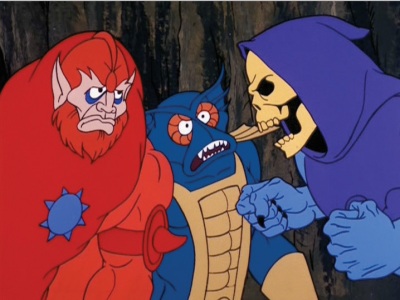 It makes you wonder if maybe they aren’t indigenous to the land they rule. In fact, we know He-Man’s mother is from Earth, an astronaut who “got lost” and wound up on Eternia, where she fell in love with the King and birthed his heir. It isn’t out of the realm of possibility to suggest that the Randors themselves are colonists, settlers who landed upon a broken world and set themselves up as its de facto rulers, using the might of He-Man—a magic stolen from Castle Grayskull—to carry out their will. It’s worth noting that for all of their talk of peace, the Randors represent at their core a military culture—not unlike the Western European crusaders, who journeyed to faraway lands to wipe out a “savage” and “accursed race.” Man at Arms is the “master of all weapons,” and Teela the captain of the royal guard. Everyone has a military designation of some sort except for Prince Adam, who is thoroughly mocked for not taking up arms and going on adventures. Cringer just wants to live his best life as a big green cat, but is forcefully drafted into service via He-Man’s power sword energy bolt, an offense that I find unsettling to this day.
It makes you wonder if maybe they aren’t indigenous to the land they rule. In fact, we know He-Man’s mother is from Earth, an astronaut who “got lost” and wound up on Eternia, where she fell in love with the King and birthed his heir. It isn’t out of the realm of possibility to suggest that the Randors themselves are colonists, settlers who landed upon a broken world and set themselves up as its de facto rulers, using the might of He-Man—a magic stolen from Castle Grayskull—to carry out their will. It’s worth noting that for all of their talk of peace, the Randors represent at their core a military culture—not unlike the Western European crusaders, who journeyed to faraway lands to wipe out a “savage” and “accursed race.” Man at Arms is the “master of all weapons,” and Teela the captain of the royal guard. Everyone has a military designation of some sort except for Prince Adam, who is thoroughly mocked for not taking up arms and going on adventures. Cringer just wants to live his best life as a big green cat, but is forcefully drafted into service via He-Man’s power sword energy bolt, an offense that I find unsettling to this day.
From time to time we will see Randor’s regime, fronted by He-Man, protecting a human or near-human tribe from the villainy of Skeletor and his goons. Often, Skeletor’s rogues are concerned with stealing, or controlling or destroying an orb, pyramid, crystal, ring, rock, or whatever object that holds some immense power or ability. Though, in the end, when He-Man saves the day, we don’t always see the ultimate fate of such objects. Sometimes they’re destroyed, sometimes they’re returned to the original owners. But sometimes the fate isn’t so clear. Is Randor acquiring these objects to protect them? To hoard them away with the rest of the secrets in Castle Grayskull?
Meanwhile, the main source of conflict is—invariably—Skeletor, a blue-skinned sorcerer and leader of a primitive band of barbarians, all of them strangely obsessed with gaining access to Castle Grayskull and its secrets. We’re told that Skeletor is evil. He even says it over and over again. But the only bad thing we ever see him do is try and access Castle Grayskull. And what exactly are Grayskull’s secrets, anyway? Has nobody noticed that Skeletor—the Eternian native who united a disparate band of resistance fighters against a militaristic monarchy—just so happens to be fighting a never-ending battle for a piece of land that has his face on it? Yet we’re told that he is the outsider, that the land must be protected from him.
Skeletor is presented as the scheming, malevolent savage with a crazy religion—a would-be usurper. He is wholly, gleefully evil. We’ve seen this narrative before: the disdain, the dismissal, the cartoonishly evil machinations, the original inhabitants of a particular parcel of land brushed aside so that white settlers could create their own vision of utopia using the resources of the conquered land as fuel. With the “evil savage” trope firmly entrenched in the purple sands of Snake Mountain, it stands to reason that Skeletor isn’t trying to conquer Castle Grayskull or Eternia. Instead, he is trying to win it back from the strange pink people who showed up from beyond the stars, installed a tyrannous monarchy, and declared themselves to be The Masters of the Universe.
![]() Jimmy Andreakos is a pop culture conspiracy theorist who reads too many comics and writes about how that makes him feel. He has bylines at Uproxx, Screen Rant, and Ranker.
Jimmy Andreakos is a pop culture conspiracy theorist who reads too many comics and writes about how that makes him feel. He has bylines at Uproxx, Screen Rant, and Ranker.
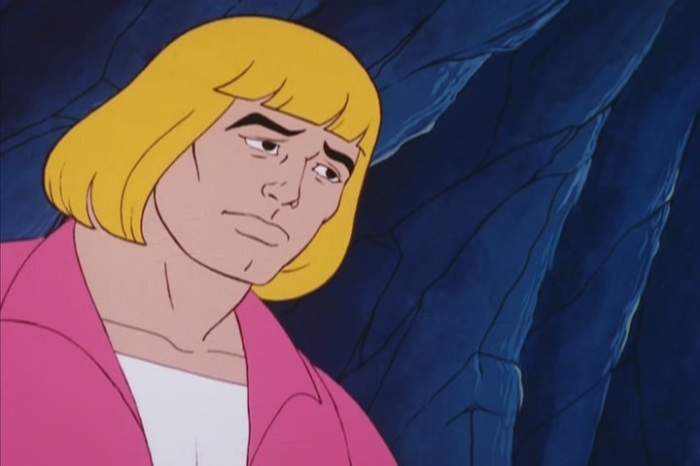
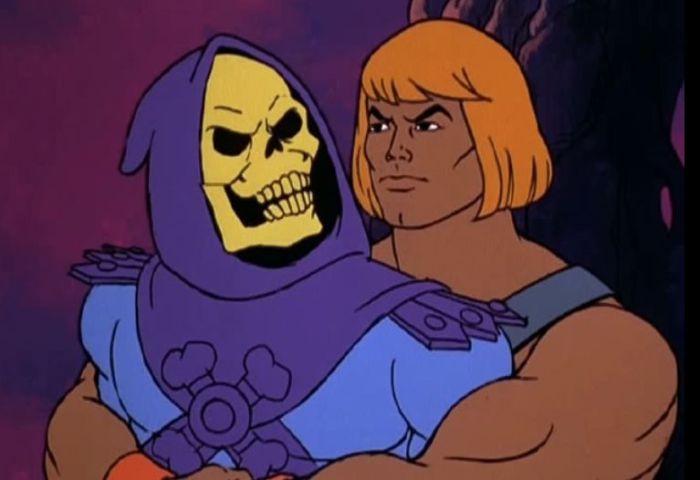




Fascinating analysis! I’m curious if the popularity of He-Man had anything to do with those ridiculously bulked-up Star Wars “Power of the Force”-branded figures released in the 1990s. Luke practically looked like The Prince of Eternia’s long lost twin in that line (while Han’s pecs threatened to snap apart his vest.)
By that time He-man was out, I think it had more to do with super hero body types.
“only the virile, sonorous He-Man is tanned, while his foppish alter ego, Prince Adam, is as white as paste—a reflection of a popular racial bias.”
Actually, that’s a reflection of the fact that European noblemen typically *were* much lighter-skinned, softer-bodied and less aggressively masculine than people (such as warriors) who had to toil outdoors for a living.
“an all-white-human citizenry”
Given it’s a stereotypical pseudo-Euro pseudo-medieval fantasy setting, that would make sense. (If I was watching a cartoon depicting a fantasy world clearly based on medieval Japan, I’d think it pretty strange if random non-Asian characters appeared without explanation.)
“the might of He-Man—a magic stolen from Castle Grayskull”
Wasn’t power more from the sword he found at Grayskull? If so, does taking an item that has no owner from an abandoned location qualify as ‘stealing’?
“to carry out their will”
As far as I can recall, He-Man only showed up to combat evil (situations that persecuted citizens of neighboring areas ask for help with), not to carry out the will of the rulers. (Kind of a ripoff of Superman crossed with King Arthur, now that I think about it.)
“the Randors represent at their core a military culture—not unlike the Western European crusaders”
They’re more of a King Arthur-esque medieval fantasy culture, where the only characters included in the story are the ones involved in the adventure. (If they were a true military culture, *then* they would have actually been conquering & enslaving their neighbors. OTOH, I suppose the women fit better into a fantasy military culture; they definitely aren’t delicate princesses in need of rescue.)
“the only bad thing we ever see [Skeletor] do is try and access Castle Grayskull.”
He also orders his minions to ensure other communities are starved, enslaved, forced to fight one another to the death, and whatever else he figures will get him closer to his goals. I mean, sure, we never see *him* do those things, but the same could be said of many historically vile leaders.
“Skeletor—the Eternian native”
He’s not a native; at some point in the original creation, it’s stated that he’s technically a demon from another dimension. (Possibly the one that the cartoon Beatles visited in Yellow Submarine, given his color…)
[Claims that Skeletor actually united ‘Resistance fighters’ to reclaim the land from the tyrannical monarchy]
Or: descendants of an immigrant who fight to protect the planet’s natives from violent persecution by the lawless creatures acting under the direction of another immigrant who wants to own not only his own land & powers, but that of everyone else around him.
Ah, I can’t resist:
“Actually, that’s a reflection of the fact that European noblemen typically *were* much lighter-skinned, softer-bodied and less aggressively masculine than people (such as warriors) who had to toil outdoors for a living.”
Only noblemen could afford to be knights (i.e. top tier warriors), actually. And only knights had horses, armor, and giant axes – like He-Man. Just substitute battle cat for horse.
“Given it’s a stereotypical pseudo-Euro pseudo-medieval fantasy setting, that would make sense. (If I was watching a cartoon depicting a fantasy world clearly based on medieval Japan, I’d think it pretty strange if random non-Asian characters appeared without explanation.)”
But it’s not a stereotypical medieval fantasy, because there are characters called Mer-Man and Stinkor and Buzz-Off. And they’re not human. How come none of them are protected by Randor?
“Wasn’t power more from the sword he found at Grayskull? If so, does taking an item that has no owner from an abandoned location qualify as ‘stealing’?”
You’re assuming that the sword has no owner. We’re assuming that the owner is Skeletor, who was booted out of Castle Grayskull because He-Man is a racist tyrant.
“They’re more of a King Arthur-esque medieval fantasy culture, where the only characters included in the story are the ones involved in the adventure. (If they were a true military culture, *then* they would have actually been conquering & enslaving their neighbors…)”
If they’re not conquering and enslaving, then why do they need a Battle Ram, War Horse, Wind Raider, Road Ripper, etc. That’s siege equipment.
“He also orders his minions to ensure other communities are starved, enslaved, forced to fight one another to the death, and whatever else he figures will get him closer to his goals. I mean, sure, we never see *him* do those things, but the same could be said of many historically vile leaders.”
Randorian propaganda. Also, they (the human invaders) should GTFO the land they stole from the colorful natives.
“He’s not a native; at some point in the original creation, it’s stated that he’s technically a demon from another dimension. (Possibly the one that the cartoon Beatles visited in Yellow Submarine, given his color…)”
Stated by whom? He-Man?
Really enjoyed this analysis. Great stuff! One thing though: He-Man’s Power/sword wasn’t stolen. It was bestowed upon him by the Sorceress of Castle Grayskull much in the way that Excalibur was given to Arthur by the Lady of the Lake.
The show was always crap. The true original mythology of Masters comes from the mini-comics that were packaged with each figure. Castle Greyskull held a magic too powerful for anyone to wield and could only be opened with the power sword. To protect the magic, at some point the sword was split into two halves so that no one person could enter and learn Greyskull’s secrets. One half was given to He-Man and the other to Skeletor. He-Man then began a career of protecting his half while Skeletor was always trying to steal it so he could enter Greyskull. That’s why the Greyskull toy had the little lock mechanism and why He-Man’s and Skeletor’s swords could be snapped together as one. Eternia, Randor, the Sorceress, stupid Orko, and the stupid Prince Adam alter ego were all inventions of the cartoon, which became popular and caused the toys to begin to reflect the show characters.
Also, the reason the original He-Man sculpt had darker skin is because it was originally going to be a line of Conan toys based on the Conan the Barbarian movie. Conan’s sword in those movies even inspired the shape of the He-Man power sword.
I was told Skeletor is actually Keldor, Randor´s brother. He tried to kill the king with acid, He-Man stopped him, but accidentally made Skeletor spill the acid on his own face , hence the skull.
Pingback: Gender Roles Included: The Unreal Estate of 1980s Playsets
Pingback: “Looks Like It’s Gonna Be A Free Country”: ‘Schoolhouse Rock!’, 1973-1976
Pingback: Train Travel Day, Which Means A Whole Trainload of Links | Gerry Canavan
Pingback: Surviving the Cursed Earth: The Mutants Recap 2018
‘Fell in love with and birthed his heir’
Really? You’re going out of your way to only mention one half of the TWINS that were born? Why no mention of Adora? She-Ra was just as big a success as He-Man and way more interesting.
This article is to Masters of the Universe what the Westboro Baptist Church is to Christianity: wrapped around the tiniest grains of truth and minuscule samplings of the source material, the rest of it deliberately misinterpreted or simply fabricated whole-cloth and given the vilest spin imaginable to suit the author’s own extreme biases and agenda.
There’s so much wrong with this article that I don’t even know where to BEGIN refuting it, and even if I did know where to start, I wouldn’t have the time to do so. The publication date puts it as just too late to be an April Fool’s joke. All I can do is shake my head in puzzlement and wonder if this article was an outright troll, or (in the words of another purple-clad villain from the 1980s), “this is bad comedy.”
Maybe my sense of humour is malfunctioning because I was a fan of the show, the toys, and the mini-comics when I was a kid and I look back on it all through rose-tinted lenses, but what I know of the moral integrity of Lou Scheimer and his crew at Filmation makes me think that’s not the case. I’m more offended on their behalf than anything else.
“Maybe my sense of humour is malfunctioning because I was a fan of the show, the toys, and the mini-comics when I was a kid and I look back on it all through rose-tinted lenses…”
Correct. Fanboy-ism and uncritical nostalgia are destructive forces that must be eliminated.
Does the “K” in your name stand for Kylo, perchance? Because “Fanboy-ism and uncritical nostalgia are destructive forces that must be eliminated” sounds unnervingly like “Let the past die. Kill it if you have to.” And “must be eliminated” also sounds pretty destructive to me. It also sounds like Disney backlashing against fans complaining that they (Disney) can’t get “Star Wars” right, despite being so derivative with it in the first place. Leave it to Team Rodent to copy the plots of “A New Hope” note-for-note, and “The Empire Strikes Back” (only reversing the order of the plot points), and STILL manage to mess it up with bad, lazy writing, then get their brainwashed myrmidons to attack their critics for them. You want a destructive force? You can’t do much better than Disney. Well, maybe Nestlé . . . .
“Critical thinking” does no good at all if you completely ignore the context of the past and deliberately misinterpret the material. Lou Scheimer’s cartoons were stunningly progressive for their time, touting fairness and equality at pretty much every step of the way, and usually had constructive life lessons for the viewers at the end of every episode that would still hold true today. Only trolls looking to cause “U Mad Bro” reactions in old-school fans would deliberately misinterpret the source material and filter it through an extremist polarised lens in such a way. That’s much more destructive — does more to foment discord and unrest — that someone simply having warm fuzzies about a cartoon from their youth.
How much did Noelle Stephenson pay for this article?
Nada. But we would totally pay Stevenson to write an article for us about why He-Man sucks.
I ended up back here in a chain from the current lead story. I am a male in the approximate He-Man target audience and age set. And I’ve always hated He-Man.
It’s garbage. I loathed all the cartoons of my youth. Mindless shit. The Reagan years were awful.
He-Man’s cross is a German iron cross, used by nazi idealists post-ww2. Skeletor’s steed is a…black panther. Evil-Lynn seems to be a yellow or olive skinned woman and she has empathy and sympathizes with Skeletor and his group. Stinkor is rejected because of a birth defect.
Then, Hordak and the horde planet of black and red. Is Hordak communism and egalitarianism? Skeletor bears alot of resemblance to ww2 propaganda posters of death or the evil enemies, he *is* Asian before his face is melted off. Beastman is near identical with the German left posters and Berlin.
And the snake men, writhing and hissing, planning, scheming, hiding in the background…are they supposed to be Jews? Considering how much Jews were associated with snakes by the nazis. Skeletor, the evil Easterner, with Evil-Lyn the mediterranean, Beastman the german left, Two-Bad the blacks (AA and non-American blacks united -i.e 2 headed), Whiplash the middle east left, Merman the French – and all are united under the red and black mark of Hordak – liberalism/communism, Tri-Clops is informants.
Prince Adam is the normal everyday Aryan, He-Man is white supremacy who transforms him into a ubermesch. Teela is the uberfrau, Man-O-War is Celtics on the right/white side (everything about him is extremely Celtic and/or British), Ram-Man is Italy (hes in Legionairre armor and the only one in Italian garb), Clamp-Champ is maybe Ethiopia or the ‘black master race’ (Ethiopia was meant for the Axis, but turned it all down), He-Man’s mother is Eve and Mother Mary, Randor is Jesus and the Aryan heritage’s rights, Buzz-Off is Japan (and knows his place to never intermix with the white women), Man-E-Faces is espionage and loyalty, Fisto is the American right, Battlecat is the inferior Aryan who’s purpose is never to intermix and be equal to their healthy superiors, but to always be loyal and be the steed for the proper Aryans (i.e. autistics, deformed, mixed race, not physically fit – they serve a purpose by being ridden and taking the brunt of punishment). The sword is the spear of destiny, Thor’s hammer, and military violence to cow the lessers. Castle Greyskull is Germany. The priestess is Egyptian and represents mysticism and occult powers to be used for power.